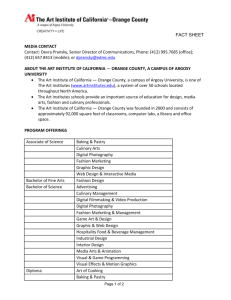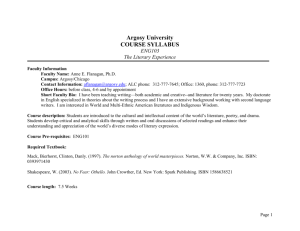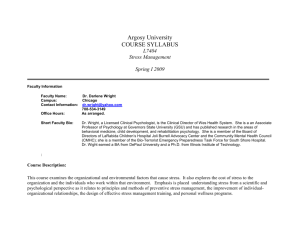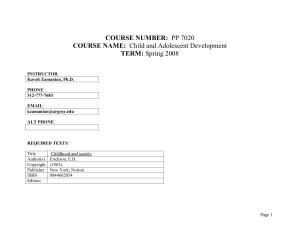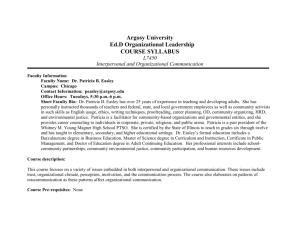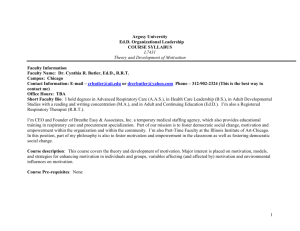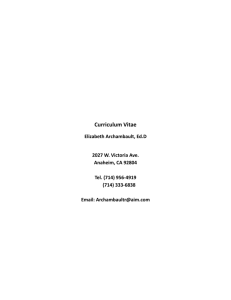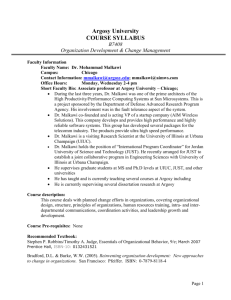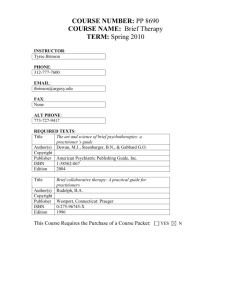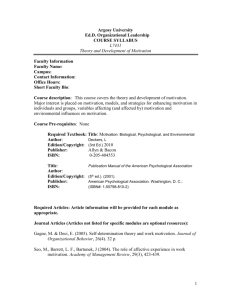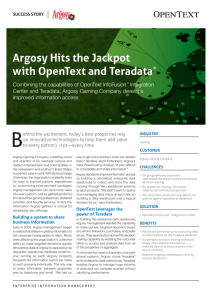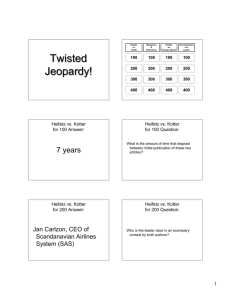Leading Through and Beyond Change
advertisement
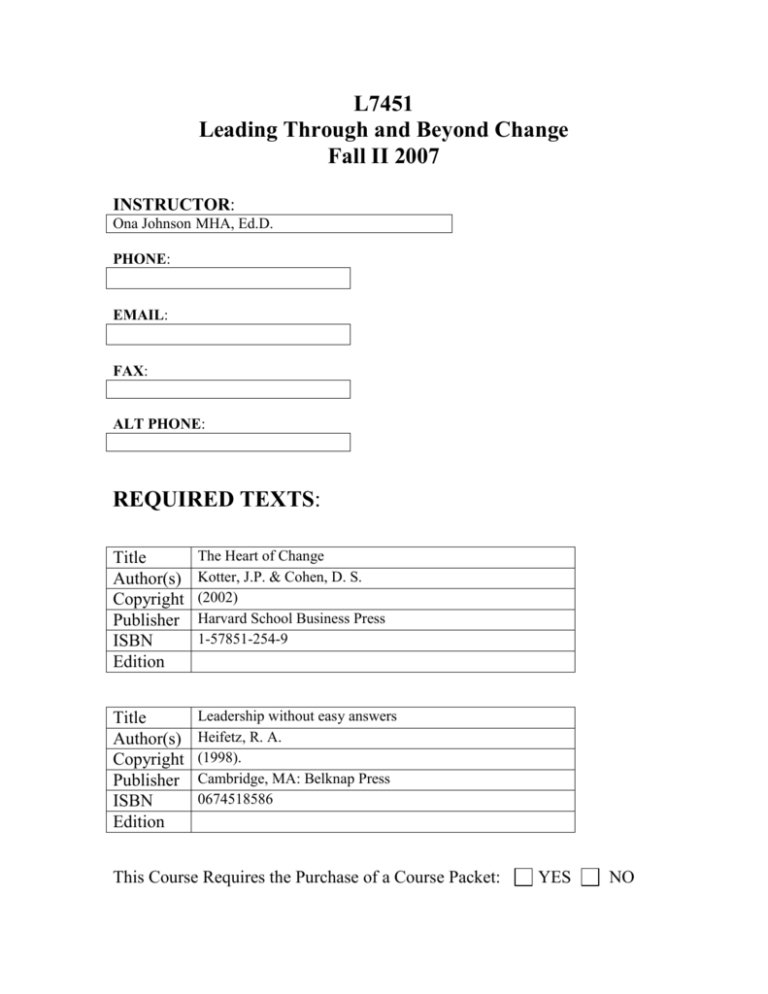
L7451 Leading Through and Beyond Change Fall II 2007 INSTRUCTOR: Ona Johnson MHA, Ed.D. PHONE: EMAIL: FAX: ALT PHONE: REQUIRED TEXTS: Title Author(s) Copyright Publisher ISBN Edition The Heart of Change Kotter, J.P. & Cohen, D. S. (2002) Harvard School Business Press 1-57851-254-9 Title Author(s) Copyright Publisher ISBN Edition Leadership without easy answers Heifetz, R. A. (1998). Cambridge, MA: Belknap Press 0674518586 This Course Requires the Purchase of a Course Packet: YES NO Argosy University Ed.D Organizational Leadership COURSE SYLLABUS L7451 Leading Through and Beyond Change Faculty Information Faculty Name: Ona Johnson Campus: Contact Information: Office Hours: Short Faculty Bio: Course description: This course focuses on expanding and extending the core curriculum in organizational leadership to include the process of change and how that process affects organizations and those who lead them. It explores resistance to change, change models, leadership challenges in facilitating change, the role of both the leader and the follower in the change process, and how to identify future trends. Course Pre-requisites: None Required Textbooks: Kotter, J.P. & Cohen, D. S. (2002). The Heart of Change. Harvard School Business Press. ISBN: 1-57851-254-9 Heifetz, R. A. (1998). Leadership without easy answers. Cambridge, MA: Belknap Press. ISBN: 0674518586 Required Article: Schein, E. H. (1996). Kurt Lewin’s change theory in the field and in the classroom: Notes toward a model of managed learning. Systems Practice (9) pp. 27-47. https://dspace.mit.edu/bitstream/1721.1/2576/1/SWP-3821-32871445.pdf 2 Required Paper: Gravenhorst, B. (2003, May). A different view on resistance to change. Power dynamics and organizational change IV. Symposium conducted at the 11th EAWOP Conference, Lisbon Portugal. http://www.pluspulse.nl/downloads/EAWOP%20resistance.pdf Required working paper: Ciulla, J. (1996). Leadership and the problem of bogus empowerment. Ethics and Leadership Working Papers. Academy of Leadership Press. http://www.academy.umd.edu/Publications/klspdocs/jciul_p1.htm Course length: 7.5 Weeks Contact Hours: 45 Hours Credit Value: 3.0 Program Outcomes: 1. Leadership in Teams: Given an organizational situation, identify strategies to develop, maintain, motivate, and sustain self-managed teams using concepts, theories and techniques of team leadership. 2. Collaboration in Teams: Given a case study or leadership situation, collect, assimilate, disseminate, and maximize the views of team stakeholders in order to reach defensible goals with minimal conflict. 3. Conflict: Given an organizational situation that requires interpersonal or interdepartmental action, identify situations of conflict, diagnose the impact of both overt and covert behavior, and develop a plan for conflict resolution using evidence-based methods. 4. Ethics: Given an organizational setting, identify ethical and dilemma-resolution practices, and make evidence-based decisions that integrate personal, social, and corporate responsibility. 3 5. Communication: Communicate orally and in writing to individuals and groups in a concise, clear, organized, and well-supported manner using formats and technology relevant to the organizational context. 6. Motivation: Given a leadership situation, identify workplace commitment theories to incorporate influences and power as a leader to motivate organizational stakeholders. 7. Research: Given an organizational need to evaluate and defend its actions or potential actions, select, analyze, and apply the assessment techniques, research methods, and/or statistical analyses needed to evaluate and defend those actions based on evidence 8. Knowledge and Understanding of the Field: Demonstrate competency in identifying and integrating the major concepts, theoretical perspectives, historical trends, and key figures in the field of organizational leadership. 9. Change: Evaluate the impact of change on organizations, organizational members, and other stakeholders and apply appropriate change models and theories to facilitate successful change. 10. Global diversity: Analyze and evaluate the involvement of diversity in leadership issues, with special attention to the implications of diversity for individuals, organizations, and societies. 11. Interpersonal Effectiveness: Achieve personal development and demonstrate positive relationship skills via effective communication, respect for others, and awareness of their impact on others. Course Objectives: By the end of the course, students will be able to: 1. Given access to current peer-reviewed journals, read, report, and apply current research on organizational change and reform through case history analysis. Program Outcomes: 1, 5, 7, 8, 9 2. Given an organizational case history, determine the personal, interpersonal, group, political, and cultural dynamics that make up the organization’s unique characteristics. Program Outcomes: 1, 2, 3, 4, 5, 6, 7, 9, 10 4 3. Using an organizational case history, analyze the case to determine ethical and effective strategies to overcome resistance and facilitate healthy change using a variety of change theories and models. Program Outcomes: 3, 4, 5, 6, 7, 9 4. Through case history analysis and personal reflection, identify the necessary characteristics of an effective change facilitator and understand the need for healthy change facilitation as well as the demands placed on a change facilitator. Program Outcomes: 4, 5, 6, 7, 8, 9, 10 5. Given case history analysis, personal reflections, and class participation, identify the need to lead effective and healthy change within organizations and be able to plan for such change using a variety of ethical strategies and models. Program Outcomes: 1, 3, 4, 5, 6, 7, 8, 9, 10 Assignment Table Week 1 Module Topics Change Models Readings Kotter: Introduction Heifetz: 1-4 Schein Article Assignments 1. Initial assignment. Prepare a 1-3 page description of an organization (or subgroup/department within an organization) that has a problem or is in need of improvement. You should provide enough detail in your written description so that others understand the essence of the situation. Do not include your ideas about potential solutions, only a description of the problem. Include no personally identifying information, titles, or names (except your own on the paper). This will be your organizational case study that you will work with during this course. 2. Choose a professional goal that you will be willing to work on and examine throughout the 5 2 Urgency Teamwork Adaptive Leadership Kotter: Step 1 & 2 Heifetz: Ch 5-7 course. Examples may include, becoming a meeting facilitator, career change, professional growth through career advancement, etc. Submit your topic with a brief 1-2 paragraph description of why you wish to make the change. 1. Professional Goal: Consider the change models previously discussed. In a 3-5 page paper, examine the type of change and what is needed to implement the change. For example, is it a 1st or 2nd order change? Continuous or discontinuous? Type I, II, or III change calling for what type of leadership? How might you create urgency for yourself in order to start making the change? Would it be appropriate to mobilize a guiding/supportive team, and why or why not? If so, identify the roles of the support team. This paper must be submitted in APA format 2. Utilizing your organizational case study, filter the change issue through the studied stages of change utilizing one of the change models presented. Analyze how individuals in the organization both see and feel about the current state and possible change, and contrast that with how they (and you) may both analyze and think about that state and change. This paper should be 2-3 pages. 3. Oral presentation: Choose a current event (the more global the better) and discuss it using Type I, II, and II change as well as 1st and 2nd order change. Give a PowerPoint team presentation to 6 3 Vision Kotter: Step 3-4 Communication and Agreement Heifetz: 8 Creative Deviance the class on the current event of your choice. 1. Team assignment: Share with a small group, a reflection of your attitude and feelings regarding the professional change. Discuss and reflect on your peers’ professional changes. Examine and compare the rationale for the changes. 2. Analyze at least one group member’s global change topic. Try to avoid emotional response, or response based solely on opinion. Consider your own reaction to the topic and explanation and discuss that as well. Utilizing the models, stages, and ideas presented thus far, continue your organizational case study. Be sure to discuss how you, as a change agent, would create the urgency or motivation necessary to initiate change. If a guiding team is appropriate, what organizational roles should be included? Schein (1996) suggests that teams are often ineffective because of the Western focus on rugged individualism. If so, how will you facilitate building a strong and effective guiding team? Finally, what is your organization’s vision? Does it need modification? If so, what might the vision be? Additionally, create a vision statement for the change itself. Be prepared to share your analysis with the instructor and the class. 3. Professional Goal: Continue to filter your efforts through the models and stages. Would you classify the process of implementing this change as adaptive leadership? Why or why not? Share 7 4 Empowering Action Positive Reinforcement Kotter: 5 & 6 Heifetz: 9 5 Tenacity Maintenance and follow through The Dangers of Change Leadership Kotter: 7-8 Heifetz: 10 Cuilla Article 6 Personal Care Heifetz: 11 your 3-5 paragraph reflection with the class 1. Case History: Communication is often something that fails in organizations, with detrimental and far reaching effects. Examine your case study for communication failures, and address how you might repair or rebuild communication channels to facilitate change. Add this outline to your continuing case history analysis. 2. Professional Goal discussion: Has your identified professional goal necessitated any type of creative deviance? How have you empowered yourself to act? Are you rewarding your positive behavior appropriately? Is it working? Share your answers with the class in a discussion. 1. Respond to the Cuilla article in 2-3 pages. Is Ciulla’s contention that bogus empowerment exists correct or incorrect? Consider your personal experience. Have you ever experienced bogus empowerment? Have you been part of or aware of an organization where this type of empowerment has occurred? Use additional sources from the literature to support your assertion. 2. Consider your current organizational case and plan. How can you ensure that your plan and approach won’t end up as bogus empowerment (Ciulla, 1996)? Write a 1-3 page reflection on these questions and submit. 1. Many theorists suggest that change agents are at 8 7 Resistance to Change 8 Final Paper Gravenhorst Article risk. Find an example of a well-known change agent, the risks they took, and the final outcome for change and for the agent and share the case with the class. 2. Professional Goal: Chart your progress. What is supporting and/or interfering with your attempts to enact professional change? Is this change necessary for you to facilitate a healthier role as a leader? Summarize your findings in a 1 – 2 page paper. 1. Utilizing your current analysis, focus on possible reasons for resistance to change, and how that resistance might be shifted. Do not mention names, only roles when discussing this resistance, reasons, and possible solutions utilizing models presented in class, as well as models found in sound academic journals. Submit a 3-5 page paper of resistance and solutions to the instructor and add it to your ongoing case analysis. 2. Professional Goal: Do you see resistance in yourself in regards to your professional change? Consider the literature presented as well as external sources to explore resistance as it applied to you and your change. Write a short summary of your experience processing change as a personal journey. Share this 3-5 paragraph summary in class. Final integrative paper. This will be a 15-20 page paper using APA format. Using your case study, integrate the ideas and theories studied in 9 class to describe a strategy and plan to facilitate the change(s) you see as necessary, as if you were an independent consultant. Special emphasis should be placed on implications and recommendations for improvement. Be certain to address the impact of change upon stakeholders, and the demands of being a change facilitator. Use peer reviewed sources and be comprehensive in scope. Grading Criteria Grading Scale A AB+ B BC+ C CF 100 - 93 92 - 90 89 – 88 87– 83 82 - 80 79 – 80 77 – 73 72 – 70 69 and below Grading requirements Attendance/participation Weekly Assignments Final paper Discussion Responses 25% 20% 35% 20% 100% Library Library Resources: Argosy University’s core online collection features nearly 21,000 full-text journals and 23,000 electronic books and other content covering all academic subject areas including Business & Economics, Career & General Education, Computers, Engineering & Applied Science, Humanities, Science, Medicine & Allied Health, and Social & Behavior Sciences. Many titles are directly accessible through the Online Public Access Catalog at http://library.argosy.edu. All resources in Argosy University’s online 10 collection are available through the Internet. The library will provide students with links, user IDs, and passwords. A detailed list of online resources is located at http://library.argosy.edu/misc/onlinedblist.html. In addition to online resources, Argosy University’s onsite collections contain a wealth of subject-specific research materials searchable in the Online Public Access Catalog. Catalog searching is easily limited to individual campus collections. Alternatively, students can search combined collections of all Argosy University Libraries. Students are encouraged to seek research and reference assistance from campus librarians. Information Literacy: Argosy University’s Information Literacy Tutorial was developed to teach students fundamental and transferable research skills. The tutorial consists of five modules where students learn to select sources appropriate for academic-level research, search periodical indexes and search engines, and evaluate and cite information. In the tutorial, students study concepts and practice them through interactions. At the conclusion of each module, they can test their comprehension and receive immediate feedback. Each module takes less than 20 minutes to complete. Please view the tutorial at http://library.argosy.edu/infolit/ Academic Dishonesty/Plagiarism: In an effort to foster a spirit of honesty and integrity during the learning process, Argosy University requires that the submission of all course assignments represent the original work produced by that student. All sources must be documented through normal scholarly references/citations and all work must be submitted using the Publication Manual of the American Psychological Association, 5th Edition (2001). Washington DC: American Psychological Association (APA) format. Please refer to Appendix A in the Publication Manual of the American Psychological Association, 5th Edition for thesis and paper format. Students are encouraged to purchase this manual (required in some courses) and become familiar with its content as well as consult the Argosy University catalog for further information regarding academic dishonesty and plagiarism. Scholarly writing: The faculty at Argosy University is dedicated to providing a learning environment that supports scholarly and ethical writing, free from academic dishonesty and plagiarism. This includes the proper and appropriate referencing of all sources. You may be asked to submit your course assignments through “Turnitin,” (www.turnitin.com), an online resource established to help educators develop writing/research skills and detect potential cases of academic dishonesty. Turnitin compares submitted papers to billions of pages of content and provides a comparison report to your instructor. This comparison detects papers that share common information and duplicative language. Americans with Disabilities Act Policy 11 It is the policy of Argosy University to make reasonable accommodations for qualified students with disabilities, in accordance with the Americans with Disabilities Act (ADA). If a student with disabilities needs accommodations, the student must notify the Director of Student Services. Procedures for documenting student disability and the development of reasonable accommodations will be provided to the student upon request. Students will be notified by the Director of Student Services when each request for accommodation is approved or denied in writing via a designated form. To receive accommodation in class, it is the student’s responsibility to present the form (at his or her discretion) to the instructor. In an effort to protect student privacy, the Department of Student Services will not discuss the accommodation needs of any student with instructors. Faculty may not make accommodations for individuals who have not been approved in this manner. The Argosy University Statement Regarding Diversity Argosy University prepares students to serve populations with diverse social, ethnic, economic, and educational experiences. Both the academic and training curricula are designed to provide an environment in which students can develop the skills and attitudes essential to working with people from a wide range of backgrounds. . 12
